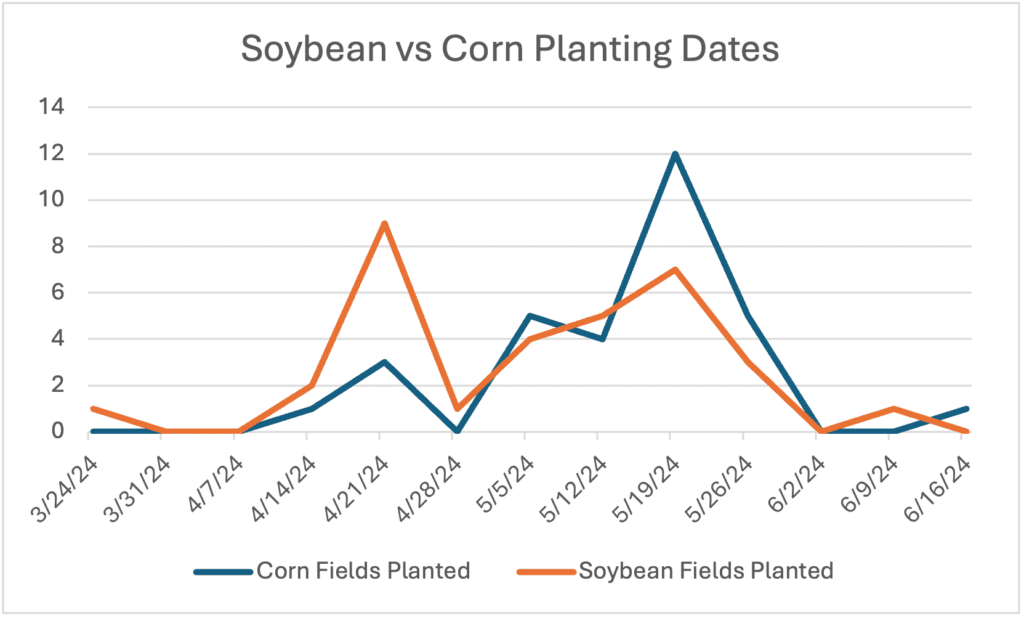When to plant what becoming now a more important choice
By Scott Gabbard, Purdue On The Farm

Last year, the first farm field planted that was enrolled with Purdue On The Farm was a soybean field planted on March 29. The next field, also soybeans, was planted on April 17. The first corn field in our set was planted on April 18.
At time of writing, soil temps at a 4-inch planting depth ranged on the Purdue Mesonet Data Hub from 37.4-degrees under cover (sod) at the Pinney Purdue Ag Center (PPAC) on the line of Porter of and LaPorte counties to 46-degrees under sod at the Southern Indiana Purdue Ag Center.
Bare soil temperatures were higher in most places, as one would expect, but only a few degrees under current conditions. You can follow along by searching for Purdue Mesonet and clicking on the Data Hub which should be the first choice. If you want to go directly to some tools referenced in the column, go to https://mrcc.purdue.edu/Ag-Climate-Tools.
I write all of this because we are getting close to #plant2025 and some might catch this column after the first rain event forces you back into the shop. Farming has changed a lot during the past two decades. Some changes have been forced due to external forces of pests, competition and markets while others have been slowly adopted over time.
Soybeans planted earlier
One of the biggest and ongoing changes at time of planting is when we plant what. It has not been that long ago that corn was planted first and then the beans were planted. While it hasn’t been a complete flip, soybeans are certainly being planted earlier now. There are several reasons why. Most of them can be narrowed down to money and risk.
Traditionally, soil temperatures need to be above 50 degrees and that has not changed. One thing that has changed slightly is that this number does not stand alone. Growing degree day accumulation has entered the conversation. While corn needs about 115 growing degree days (GDDs), soybeans need about 130. So, it’s a combination of soil temperatures and the accumulation of GDDs that determine how fast and uniform the crop pops out of the ground and develops through its early phases of vegetative growth.
Once the plants hit roughly R5 for corn and the first 10 days after emergence have passed for the beans, the plants are reliant upon ambient air temperatures, GDD accumulations, moisture and sunlight. Soybeans aren’t completely out of the woods because growing conditions should be good to at least V2-V3 for optimum nodule development.
Soybeans are also more susceptible to late season cold snaps. If the seedlings die back to below the cotyledon, the plant will die. If the first or second trifoliate is smoked, the plant (or field) will look bad but the plant will regrow with the caveat that conditions need to improve enough so that enough energy is consumed for new leaf development.
If confronted with this challenge, wait a week and re-check the field, beans by nature are resilient. With corn, the growth point is still below the ground until V4-V5. Corn is not without it’s cold-snap problems, buggy-whipping can prevent proper whorl emergence.
Consider growth characteristics
So why plant the beans first? Most of it has to due with node development, canopy closure and ultimately higher yield. One also needs to consider the growth characteristics of the two crops.

Soybeans simply do not need the stand emergence uniformity that corn demands. Corn requires uniform emergence which should translate to uniform tassel and silk emergence. If not, pollination is affected.
With soybeans , canopy closure is arguably more important. Soybeans can “fill in” whereas delayed germination of corn becomes weeds. When the canopy closes for beans, weed pressures are reduced and the beans are off to the races.
For corn, it is more important that the stand is uniform and that conditions are right during pollination for uniform development. Another way to look at it is that corn requires that we get it right, soybeans ask that we are close.
There is more to it than oversimplified relationships between corn and soybean planting and which to do first. Soybeans are just a little more forgiving than corn and there is a yield premium if conditions are right throughout the entire growing season. That will have to wait for future columns.
Midwest-wide trends and our own data illustrate that soybeans have a little more management flexibility than corn. Instead of waiting for optimum conditions for planting corn, consider planting some beans to knock out some acres first and when soil temperatures are in the 50s. Switch to corn when soil temperatures are more ideal, averaging in the lower sixties.
While nothing is perfect when planting, this might take off some stress when planting and add a few smiles later when you’re filling the bins. So, while the sun might be shining and you’ve shed your jacket, you might want to check that temperature and future weather conditions first.
Posted: March 21, 2025
Category: 2025 Planting Season, ICMC, Indiana Corn and Soybean Post - March 2025, ISA, News, Purdue University, Sustainability



